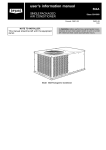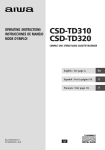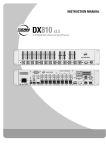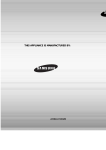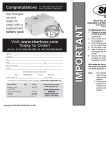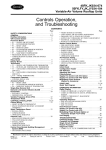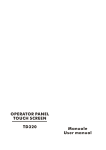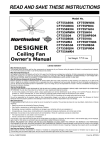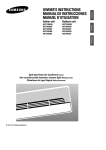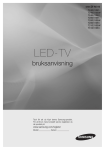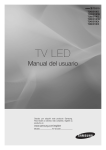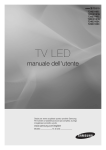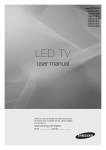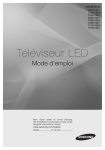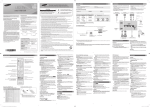Download Aiwa CSD-TD310 Operating instructions
Transcript
OPERATING INSTRUCTIONS INSTRUCCIONES DE MANEJO MODE D’EMPLOI CSD-TD310 CSD-TD320 COMPACT DISC STEREO RADIO CASSETTE RECORDER English : See page 2. 8A-CHB-933-01 010405ACK-I-AIS En Español : Ver la página 10. E Français : Voir page 18. F U WARNING TO REDUCE THE RISK OF FIRE OR ELECTRIC SHOCK, DO NOT EXPOSE THIS APPLIANCE TO RAIN OR MOISTURE. CAUTION RISK OF ELECTRIC SHOCK DO NOT OPEN “CAUTION:TO REDUCE THE RISK OF ELECTRIC SHOCK, DO NOT REMOVE COVER (OR BACK). NO USER-SERVICEABLE PARTS INSIDE. REFER SERVICING TO QUALIFIED SERVICE PERSONNEL.” Explanation of Graphical Symbols: The lightning flash with arrowhead symbol, within an equilateral triangle, is intended to alert the user to the presence of uninsulated “dangerous voltage” within the product’s enclosure that may be of sufficient magnitude to constitute a risk of electric shock to persons. The exclamation point within an equilateral triangle is intended to alert the user to the presence of important operating and maintenance (servicing) instructions in the literature accompanying the appliance. OWNER’S RECORD For your convenience, record the model number (you will find it at the bottom of the unit) and serial number (you will find it in the battery compartment) in the space provided below. Please refer to them when you contact your AIWA dealer in case of difficulty. Model No. Serial No. Precautions Read the Operating Instructions carefully and completely before operating the unit. Be sure to keep the Operating Instructions for future reference. All warnings and cautions in the Operating Instructions and on the unit should be strictly followed, as well as the safety suggestions below. Installation 1 Water and moisture - Do not use this unit near water, such as near a bathtub, washbowl, kitchen sink, laundry tub, in a wet basement, swimming pool, or the like. 2 Heat - Do not use this unit near sources of heat, including heating vents, stoves, or other appliances that generate heat. It also should not be placed in temperatures less than 5°C (41°F) or greater than 35°C (95°F). 3 Mounting surface - Place the unit on a flat, even surface. 4 Ventilation - The unit should be situated with adequate space around it so that proper heat ventilation is assured. Allow 10 cm (4 in.) clearance from the rear and the top of the unit and 5 cm (2 in.) from each side. - Do not place the unit on a bed, rug, or similar surface that may block the ventilation openings. - Do not install the unit in a bookcase, cabinet, or airtight rack where ventilation may be impeded. 5 Objects and liquid entry - Take care that objects or liquids do not get inside the unit through the ventilation openings. 6 Carts and stands - When placed or mounted on a stand or cart, the unit should be moved with care. Quick stops, excessive force, and uneven surfaces may cause the unit or cart to overturn or fall. 7 Condensation - Moisture may form on the CD pickup lens when: - The unit is moved from a cold spot to a warm spot - The heating system has just been turned on - The unit is used in a very humid room - The unit is cooled by an air conditioner When this unit has condensation inside, it may not function normally. Should this occur, leave the unit for a few hours, then try to operate again. 8 Wall or ceiling mounting - The unit should not be mounted on a wall or ceiling, unless specified in the Operating Instructions. Electric Power 1 Power sources - Use on batteries or AC house current, as specified in the Operating Instructions and marked on the unit. 2 Polarization - As a safety feature, some units are equipped with polarized AC power plugs which can only be inserted one way into a power outlet. If it is difficult or impossible to insert the AC power plug into an outlet, turn the plug over and try again. If it still does not easily insert into the outlet, please call a qualified service technician to service or replace 2 ENGLISH Power supply the outlet. To avoid defeating the safety feature of the polarized plug, do not force it into a power outlet. 3 AC power cord - When disconnecting the AC power cord, pull it out by the AC power plug. Do not pull the cord itself. - Never handle the AC power plug with wet hands, as this could result in fire or shock. - Power cords should be firmly secured to avoid being bent, pinched, or walked upon. Pay particular attention to the cord from the unit to the power socket. - Avoid overloading AC outlets and extension cords beyond their capacity, as this could result in fire or shock. 4 Extension cord - To help prevent electric shock, do not use a polarized AC power plug with an extension cord, receptacle, or other outlet unless the polarized plug can be completely inserted to prevent exposure of the blades of the plug. 5 When not in use - Unplug the AC power cord from the AC outlet or remove all the batteries if the unit will not be used for several months or more. When the cord is plugged in, a small amount of current continues to flow to the unit, even when the power is turned off. Maintenance Clean the unit only as recommended in the Operating Instructions. Damage Requiring Service Have the units serviced by a qualified service technician if: - The AC power cord or plug has been damaged - Foreign objects or liquid have got inside the unit - The unit has been exposed to rain or water - The unit does not seem to operate normally - The unit exhibits a marked change in performance - The unit has been dropped, or the cabinet has been damaged DO NOT ATTEMPT TO SERVICE THE UNIT YOURSELF. OPE/BATT The OPE/BATT indicator lights up while the power is on. Using on AC house current Connect the AC cord as illustrated below. to the AC inlet of the unit supplied AC cord to an AC outlet (AC 120 V, 60 Hz) CAUTION Use only the supplied AC cord. Use with other cords may result in the risk of fire. En Using on batteries Open the lid of the battery compartment on the rear and insert eight R14 (size C) batteries, not supplied, with the 0 and 9 marks correctly aligned. Then close the lid. To switch from AC power supply to battery power supply, disconnect the AC cord from the AC inlet. R14 (C) When to replace the batteries The OPE/BATT indicator becomes dim, the tape speed slows down, volume decreases, or sound is distorted during operation. Notes on batteries • Do not mix different types of batteries or old batteries with new ones. • When the unit is not to be used for a long period, remove the batteries to prevent needless battery wear. • Never recharge the batteries, apply heat to them or take them apart. • Remove dead batteries. If liquid leaks from the batteries, wipe thoroughly to remove. ENGLISH 3 Preview Limit Reached! To view more of this manual, please visit: http://freemanualdownload.com/Aiwa-CSDTD320-free-m anual-download




